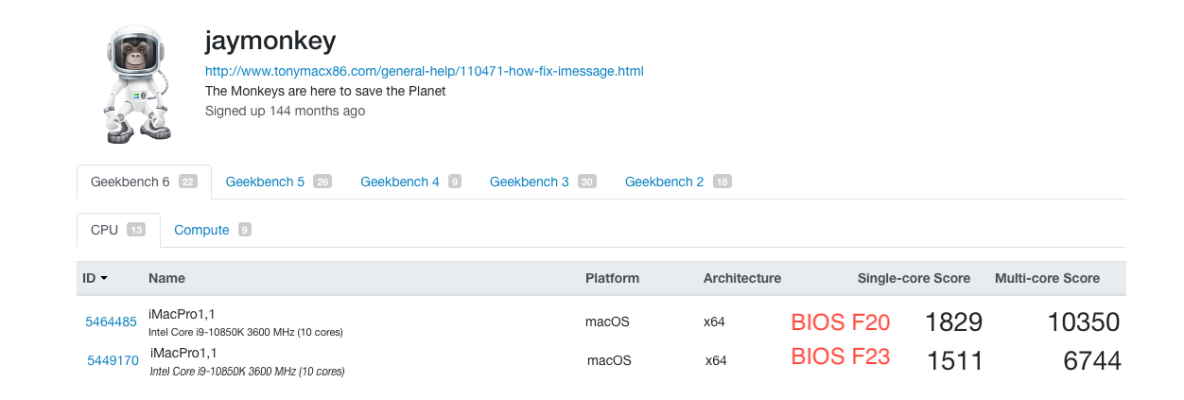To all Gigabyte Z490 Vision G users (and probably Vision D)
Don't be tempted to update to a BIOS newer than F20 (or whats recommended in the build guide)
Here's why ....
I had been running BIOS F20 on my Z490 Vision G for a few years now, but in a moment of unclarity I ignored all of my internal warnings and decided to update the BIOS to F23, after all according to the Gigabyte support site there were tons of security fixes .... what's the worse that can happen ... right ?

After updating to F23 and re-setting the BIOS options, MacOS booted and worked as before .... all seemed good.
However after a few days I started to notice some odd behaviour when playing YouTube videos, the audio was fine but video playback was stuttering / glitching. Using Intel Power Gadget to monitor the IGPU load it became very clear that the IGPU was behaving very erraticly in a good/bad cycle were during playback the IGPU seemed to work ok for a few seconds then it would freeze for a a few seconds (video play back would also freeze) then back to ok, then not ... etc.
I checked the IGPU config and all was correct, I tried a few other IGPU configs and also removing the IGPU device properties and letting WhatEverGreen do its thing but no matter what I tried this odd behaviour continued.
Eventually I disabled the IGPU in the BIOS to force MacOS to default all codec decode on to my RX 6800 XT and after doing this the Video playback issues were gone.
I ran the system like this for several weeks and all was fine however I started to get the feeling that the system was not performing as it used to. So I decided to run Geekbench 6 and check the result agaist the result I had already when the system was running on BIOS F20.
To my utter shock the system had lost around 30% performance in Geekbench, I also checked using Cinebench who's results also confirmed the loss of performance.
I checked all the BIOS setings to make sure I had everything correct, such as XMP enabled and the same overclock settings I had before ... which they were. I tried mutilpe changes to the BIOS settings but no matter what the system performance was some 30% down.
I can only attribute the poor performance to the multitude of Intel ME CPU patches included in BIOS versions F21 - F23 such as Meltdown, Spectre ... etc (it's a long list). As for what was wrong with the IGPU I have no idea, I could not find any mention of the issue on any Hackintosh web sites and the problem did not show up in Windows so it appears to be MacOS specific.
So all in all updating the BIOS was an utter disaster.
Time to switch back to BIOS F20 ..... Unfortunately since BIOS F21 Gigabyte introduced a
Capsule BIOS which means no possibility of downgrading the BIOS, at least through any of the Gigabyte QFlash utilities

After a few days of cursing and researching the issue I found that it is possible to downgrade the BIOS back to F20 by booting into Windows 11 and using Intel’s Flash Programming Tool (FPT) which is part of Intel's (CS)ME System Tools package.
Note 1: Unlike the Gigabyte QFlash utilities, the Intel FPT tool does not check/validate the BIOS binary that you select to flash with, so there is a possibility of bricking your motherboard if you flash with the wrong file.
Note 2: I think that it is possible to downgrade a Capsule BIOS using the QFlash Plus feature however all the documentation I found on this indicated that the FQlash Plus feature is meant to be used with no CPU and GPU not installed in the motherboard.
I did not want to remove anything from the system so opted to try the Intel Flash Programming Tool (FPT).
After booting into Windows and downloading the correct Intel (CS)ME System Tools package, I ran FPTW64 and held my breath as the Intel Flash Programming Tool went ahead and erased multiple regions of the UEFI followed by flashing the same regions with the selected BIOS/UEFI image (F20) ... after it finished I rebooted and after a somewhat longer than usual reboot time entreated the BIOS to confirm that it was indeed F20 (it was) .. phew.
I re-set the BIOS options, booted back in to MacOS and re-ran Geekbench 6 to confirm that the system performance was back to what it was before all of this.
 So What have we learned ?
So What have we learned ?
1. Don't be tempted to update to a later BIOS unless you absolutely have no option and need to do it to support a specific need, if you do be prepared to sacrifice some system perfomance.
2. If you do update to a later BIOS, MacOS should stilll run ok but performance will most likely be affected and you may encounter the strange IGPU issue that I did.
3. All those Intel ME CPU patches to fix CPU vulnerabilities such as Spectre, Meltdown ...etc really do have an adverse effect on system performance.
4. If it's not broken, don't try to fix it.
Hopefully this post will help other to avoid the pain I went through.
Cheers
Jay



